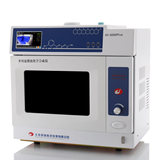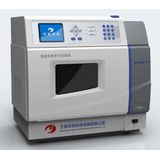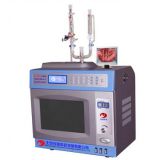搜全站
搜展位
解决方案
微波辅助合成介孔MgO@Carbon混合纳米复合材料 以增强对羟基化合物的催化降解作用
应用领域
材料检测样品
纳米材料检测项目
其他采用微波辅助水热和煅烧相结合的方法生产系列介孔氧化镁@碳(MgO@C)混合纳米复合材料,并通过TEM、XPS、XRD和拉曼光谱进行研究和验证。通过TEM、XPS、XRD和拉曼光谱的研究和验证。煅烧后的MgO@C纳米复合材料具有较高的比表面积和较小的晶粒尺寸,在优化制备后具有较强的降解对苯二酚能力。在室温下,MgO@C-600分解的对氨基苯酚毒素量约为55.65mg/g@90min。此外,拟二阶动力学模型(R2>0.99)更适合实验降解数据。MgO@C-600的强化降解机制制得到了验证,使用氯化硝基蓝四唑(NBT)作为探针来检测更多的超氧自由基(-O2-)活性点的产生。光热效。与非辐照样品相比,在808纳米的近红外(NIR)辐射下,去除效率提高了8倍。由于它们易于制造,成本低,而且去除效率高。MgO@C纳米复合材料可以作为一种合适的吸附剂,用于消除有机磷危险污染物。

共1台
大幅提高光催化活性的N-掺杂碳点/大孔二氧化钛复合材料(N-CDs/TiO2)的构建
应用领域
材料检测样品
金属材料基复合材料检测项目
其他成功地制备了一种高效的助催化剂,即N-CDs/m-TiO2,并将其用于降解甲基溴。显著提高了光催化活性。

共2台
_微波水热法制备Gd掺杂的碳量子点型高性能磁共振-荧光双模态分子影像探针
应用领域
材料检测样品
碳材料检测项目
掺杂的碳量子点型高性能磁共振以同时提供钆源和碳源的钆喷酸单葡甲胺为前驱体,利用微波作为加热手段实现分子水平上的搅拌,
达到低温#短时间内制得均匀的小粒度=>)*掺杂碳量子点(=>)*H8]D67!c)的目的"当前驱体在%,1k下微波水热反应$,:;/时,获得的=>)*H8]D67!c表现出较高的量子产率和极强的磁共振性能,避免了传统加热方式对碳量子点的发光能力和弛豫性能极难同时提高的矛盾"该条件下合成出尺寸约+f1/:的碳量子点,其荧光量子产率为++f1a,=>)*的掺杂质量分数达+-fBa,纵向弛豫性能高达$,$,f)::"Mn+!C!6n+
([=>)*]g1f1+::"M!Cn+)!并且,该碳量子点对c5C3细胞无明显毒性,有望用作高弛豫性能和高发光性能的磁共振7荧光双模态探针"

共1台
300UL 微波法合成纳米FeVO_4及其光催化性能_费乾峰
应用领域
材料检测样品
纳米材料检测项目
样品制备性能通过微波法合成纳米 FeVO4 光催化剂,用 XRD、SEM、UV-Vis DRS 对其进行表征,
探究不同 Fe:V 摩尔比、不同微波反应时间及 Cu2+掺杂对产物的形貌、结晶度、粒径以及带隙
的影响。 结果表明,当 Fe:V=1、微波反应 6 min 时,制备条件较优,获得了粒度比较均匀、尺寸
较小、形貌比较规则的 FeVO4 晶体,且结晶度较高、带隙较窄。 选取优化条件下制备的 FeVO4
与 FeVO4 :Cu2+,在可见光下进行甲基橙降解试验。 在初始甲基橙浓度为 10 mg/L、反应 160
min 时,FeVO4 :Cu2+对甲基橙的降解率达到 76.4%。

共1台
Microwave-assisted synthesis nanocomposite for supercapacitor(微波辅助合成纳米材料)
应用领域
材料检测样品
纳米材料检测项目
Abstract
An organic–inorganic poly(3,4-ethylenedioxy-thiophene) (PEDOT)/RuO2·xH2O nanocomposite (approxi-mately 1 wt.% RuO2) has been successfully prepared for the first time under microwave irradiation within 5 min with power 900 W via in situ chemical polymerization. The morphology and structure of the resultant material is characterized by transmission electron microscope and Fourier transform infrared. Moreover, the electrochemical properties of the synthesized nanocomposite can be controlled by adjusting the annealing temperature, which is definitely illustrated by cyclic voltammetry, galvanostatic charge–discharge, and electrochemical impedance spectra. Electrochemical data have shown that the PEDOT/RuO2·xH2O nanocomposite annealed at 150 °C possesses the most favorable charge/discharge ability with a specific capacitance of 153.3 F g?1at a current density of 150 mA g?1 and the high efficient utilization of PEDOT at various current densities. Furthermore, such composite has a less capacitance degradation of 23.8% after 1,000 continuous cycles. The improved electrochemical performance are mainly attributed to the large electroactive surface of nanocomposite and the existence of amorphous RuO2·xH2O particles as well as a synergistic effect of the polymer PEDOT and annealed RuO2·xH2O. Thus, the PEDOT/RuO2·xH2O nanocomposite annealed at 150 °C can act as a promising electroactive material for supercapacitor application

共1台





